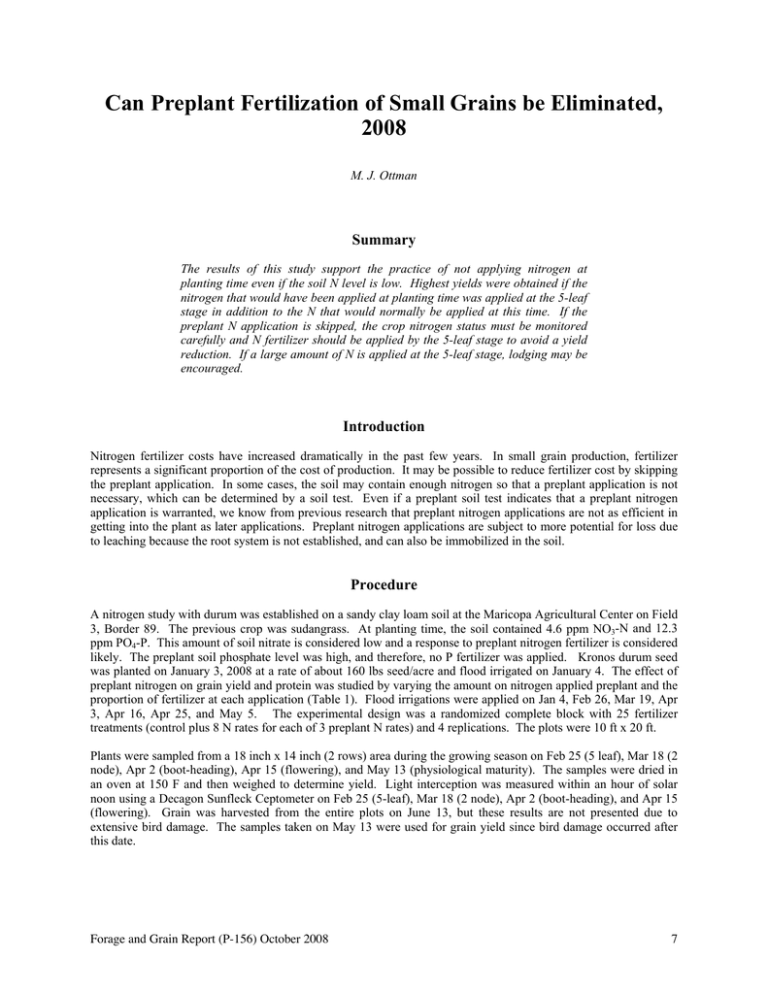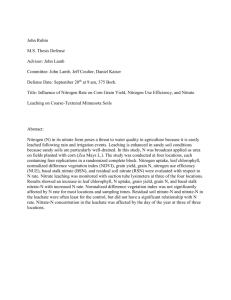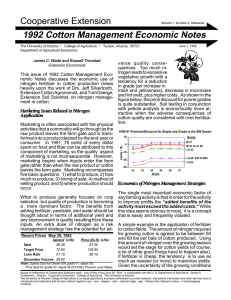Can Preplant Fertilization of Small Grains be Eliminated, 2008 Summary
advertisement

Can Preplant Fertilization of Small Grains be Eliminated, 2008 M. J. Ottman Summary The results of this study support the practice of not applying nitrogen at planting time even if the soil N level is low. Highest yields were obtained if the nitrogen that would have been applied at planting time was applied at the 5-leaf stage in addition to the N that would normally be applied at this time. If the preplant N application is skipped, the crop nitrogen status must be monitored carefully and N fertilizer should be applied by the 5-leaf stage to avoid a yield reduction. If a large amount of N is applied at the 5-leaf stage, lodging may be encouraged. Introduction Nitrogen fertilizer costs have increased dramatically in the past few years. In small grain production, fertilizer represents a significant proportion of the cost of production. It may be possible to reduce fertilizer cost by skipping the preplant application. In some cases, the soil may contain enough nitrogen so that a preplant application is not necessary, which can be determined by a soil test. Even if a preplant soil test indicates that a preplant nitrogen application is warranted, we know from previous research that preplant nitrogen applications are not as efficient in getting into the plant as later applications. Preplant nitrogen applications are subject to more potential for loss due to leaching because the root system is not established, and can also be immobilized in the soil. Procedure A nitrogen study with durum was established on a sandy clay loam soil at the Maricopa Agricultural Center on Field 3, Border 89. The previous crop was sudangrass. At planting time, the soil contained 4.6 ppm NO3-N and 12.3 ppm PO4-P. This amount of soil nitrate is considered low and a response to preplant nitrogen fertilizer is considered likely. The preplant soil phosphate level was high, and therefore, no P fertilizer was applied. Kronos durum seed was planted on January 3, 2008 at a rate of about 160 lbs seed/acre and flood irrigated on January 4. The effect of preplant nitrogen on grain yield and protein was studied by varying the amount on nitrogen applied preplant and the proportion of fertilizer at each application (Table 1). Flood irrigations were applied on Jan 4, Feb 26, Mar 19, Apr 3, Apr 16, Apr 25, and May 5. The experimental design was a randomized complete block with 25 fertilizer treatments (control plus 8 N rates for each of 3 preplant N rates) and 4 replications. The plots were 10 ft x 20 ft. Plants were sampled from a 18 inch x 14 inch (2 rows) area during the growing season on Feb 25 (5 leaf), Mar 18 (2 node), Apr 2 (boot-heading), Apr 15 (flowering), and May 13 (physiological maturity). The samples were dried in an oven at 150 F and then weighed to determine yield. Light interception was measured within an hour of solar noon using a Decagon Sunfleck Ceptometer on Feb 25 (5-leaf), Mar 18 (2 node), Apr 2 (boot-heading), and Apr 15 (flowering). Grain was harvested from the entire plots on June 13, but these results are not presented due to extensive bird damage. The samples taken on May 13 were used for grain yield since bird damage occurred after this date. Forage and Grain Report (P-156) October 2008 7 Results and Discussion Light interception provides an indication of plant growth, and leaf area in particular. Greater light interception is correlated with greater leaf area. At the 5-leaf stage, light interception was not affected by nitrogen rate showing no response to preplant nitrogen fertilizer (Table 2). At the 2-node stage, light interception was less if N was 0 preplant and only 1x at 5-leaf. By the boot-heading stage, light interception was greatest where N application was 0 preplant and 2x at 5-leaf. Preplant N affected plant growth during the season (Table 2). At the 2-node stage, greatest plant growth was measured where preplant N was applied. However, by the boot-heading stage, we were not able to measure differences in plant growth whether or not preplant N was applied. At the end of the season, skipping the preplant N application resulted in reduced plant growth if N application at the 5 leaf stage was only 1x instead of 2x. However, grain yield was not affected by preplant N application, although grain yield was increased by the 2x N application at the 5-leaf stage (Table 3). Preplant N hastened the time to heading and flowering by about 1 day. N application at a 2x rate at the 5-leaf stage increased lodging. Preplant N had no affect on harvest index, test weight, HVAC, grain protein, or plant height. The results of this study suggest that preplant N can be delayed until the 5-leaf stage without reducing yield even on a soil low in nitrate. Acknowledgments Financial support for this project was received from the Arizona Grain Research and Promotion Council. The technical assistance of Mary Comeau and Mike Sheedy is greatly appreciated. Forage and Grain Report (P-156) October 2008 8 Table 1. Nitrogen fertilizer treatments. N Rate (lbs N/A) Flowering watery kernel (Apr 16) Preplant 5-leaf Total N rate lbs N/A Preplant (Jan 4) 5-leaf (Feb 26) 2-node (Mar 19) Bootheading (Apr 3) N/A N/A 0 0 0 0 0 0 1x 1x 50 100 150 200 250 300 350 400 10 20 30 40 50 60 70 80 10 20 30 40 50 60 70 80 10 20 30 40 50 60 70 80 10 20 30 40 50 60 70 80 10 20 30 40 50 60 70 80 0 2x 50 100 150 200 250 300 350 400 0 0 0 0 0 0 0 0 20 40 60 80 100 120 140 160 10 20 30 40 50 60 70 80 10 20 30 40 50 60 70 80 10 20 30 40 50 60 70 80 0 1x 40 80 120 160 200 240 280 320 0 0 0 0 0 0 0 0 10 20 30 40 50 60 70 80 10 20 30 40 50 60 70 80 10 20 30 40 50 60 70 80 10 20 30 40 50 60 70 80 Forage and Grain Report (P-156) October 2008 9 Table 2. Preplant and subsequent N application effect on light interception and total plant yield at various growth stages. N application Light Interception Total Plant Yield Boot- FlowerBoot- FlowerTotal 5-leaf 2-node heading water 5-leaf 2-node heading water Maturity lbs N/A ------------- % of incident ------------- ------------------------ lbs/A ------------------------ Preplant 5-leaf 0 0 0 24 53 61 58 205 1,543 2,352 4,207 5,489 1x 1x 50 100 150 200 250 300 350 400 26 34 39 38 53 39 46 29 57 73 76 78 81 79 79 76 69 80 86 84 91 90 92 91 68 80 82 83 91 88 90 88 355 429 442 274 529 492 498 274 2,875 2,340 3,348 1,904 3,896 4,393 4,144 2,751 3,547 3,696 5,526 6,671 5,750 6,148 4,543 4,070 6,770 7,542 5,912 5,501 9,496 8,924 9,135 7,816 11,027 8,276 13,416 13,304 14,138 13,292 14,400 6,808 0 2x 50 100 150 200 250 300 350 400 ----------------- 63 69 77 72 75 76 86 81 75 84 92 88 91 92 97 94 70 79 92 86 90 93 94 94 ----------------- 2,526 2,390 2,775 2,551 2,713 1,357 2,402 3,037 3,609 4,368 4,306 4,294 4,418 5,762 4,543 5,215 6,186 6,845 8,625 8,650 8,102 7,604 11,089 9,471 9,434 14,089 14,561 8,787 14,213 14,051 11,998 15,072 0 1x 40 80 120 160 200 240 280 320 ----------------- 58 62 68 64 73 66 75 76 71 74 81 82 89 86 93 91 66 72 81 83 90 85 90 89 ----------------- 2,340 2,278 1,892 2,178 2,340 1,991 2,539 1,543 3,647 5,538 4,082 4,891 5,028 4,256 5,339 5,028 8,712 6,111 8,575 8,027 8,575 7,393 8,301 6,982 9,322 10,056 9,869 9,036 13,143 9,496 12,010 12,608 NS --- 9 NS 6 NS 5 NS NS --- 1101 + 1673 NS 2736 NS 3533 * Avg. Avg. Avg. 38 ----- 75 75 68 85 89 84 84 87 82 416 ----- 3,206 2,469 2,138 4,994 4,564 4,726 7,637 8,322 7,835 11,833 12,776 10,692 Avg. N --47 3 10 2 5 2 5 --50 395 25 NS 21 NS 20 1267 18 LSD.10 All N Preplant N * Total N rate 1x 0 0 LSD.10 CV(%) 1x 2x 1x LSD.10 = least significant difference at the 10% probability level. NS, +, * = not significant at the 10% probability level, significant at the 10% probability level, and significant at the 5% probability level, respectively. CV = coefficient of variation. Forage and Grain Report (P-156) October 2008 10 Table 3. Preplant and subsequent N application effect on grain yield and various grain and plant characteristics. N application Preplant 5-leaf Total lbs N/A Grain yield lbs/A HVAC % Grain protein % Heading 0 0 0 2,775 51 61 57 10.7 3/29 4/01 25 0 1x 1x 50 100 150 200 250 300 350 400 5,314 3,983 6,484 6,410 6,397 5,439 5,974 2,166 48 48 48 48 45 41 41 30 62 62 61 61 61 61 60 60 83 92 98 99 99 100 99 98 11.2 12.6 13.3 14.5 14.1 14.7 14.8 14.8 3/30 3/30 3/29 3/30 3/28 3/30 3/30 4/01 4/02 4/01 4/01 4/02 4/01 4/03 4/03 4/03 27 27 26 26 27 27 28 26 0 8 20 18 45 33 38 15 0 2x 50 100 150 200 250 300 350 400 4,493 6,721 7,107 4,568 6,534 6,584 5,078 6,036 48 48 49 52 46 47 42 40 62 61 61 61 61 60 60 61 82 93 99 99 98 100 98 99 11.4 12.5 14.0 15.0 14.6 15.1 14.7 14.5 3/30 3/31 3/30 3/31 3/31 4/01 3/30 4/01 4/02 4/04 4/02 4/02 4/04 4/04 4/03 4/04 27 27 27 26 26 26 27 27 0 8 53 63 45 60 68 60 0 1x 40 80 120 160 200 240 280 320 4,916 5,240 4,929 4,406 5,551 3,933 5,115 5,277 53 52 50 47 42 42 42 42 62 62 61 61 61 60 60 60 82 94 96 96 100 99 99 100 11.4 12.6 13.2 14.3 14.7 15.2 15.1 15.1 3/29 3/29 3/30 3/30 3/31 3/31 4/01 4/01 4/02 4/01 4/02 4/03 4/03 4/03 4/04 4/04 27 26 27 26 27 26 27 26 0 3 15 43 33 33 38 78 1786 * NS NS 1 NS 6 NS 0.7 NS 2 NS 2 NS NS NS 26 + Avg. Avg. Avg. 5,271 5,890 4,921 44 47 46 61 61 61 96 96 96 13.7 14.0 14.0 3/30 3/31 3/30 4/02 4/03 4/03 27 27 26 22 44 30 Avg. N 642 20 NS 13 NS 1 NS 5 NS 4 1 0 1 0 NS 6 9 70 LSD.10 All N Preplant N * Total N rate 1x 0 0 LSD.10 CV(%) 1x 2x 1x Harvest Test Index weight % lbs/bu Flower- Plant Height Lodging ing inches % LSD.10 = least significant difference at the 10% probability level. NS, +, * = not significant at the 10% probability level, significant at the 10% probability level, and significant at the 5% probability level, respectively. CV = coefficient of variation. Forage and Grain Report (P-156) October 2008 11




